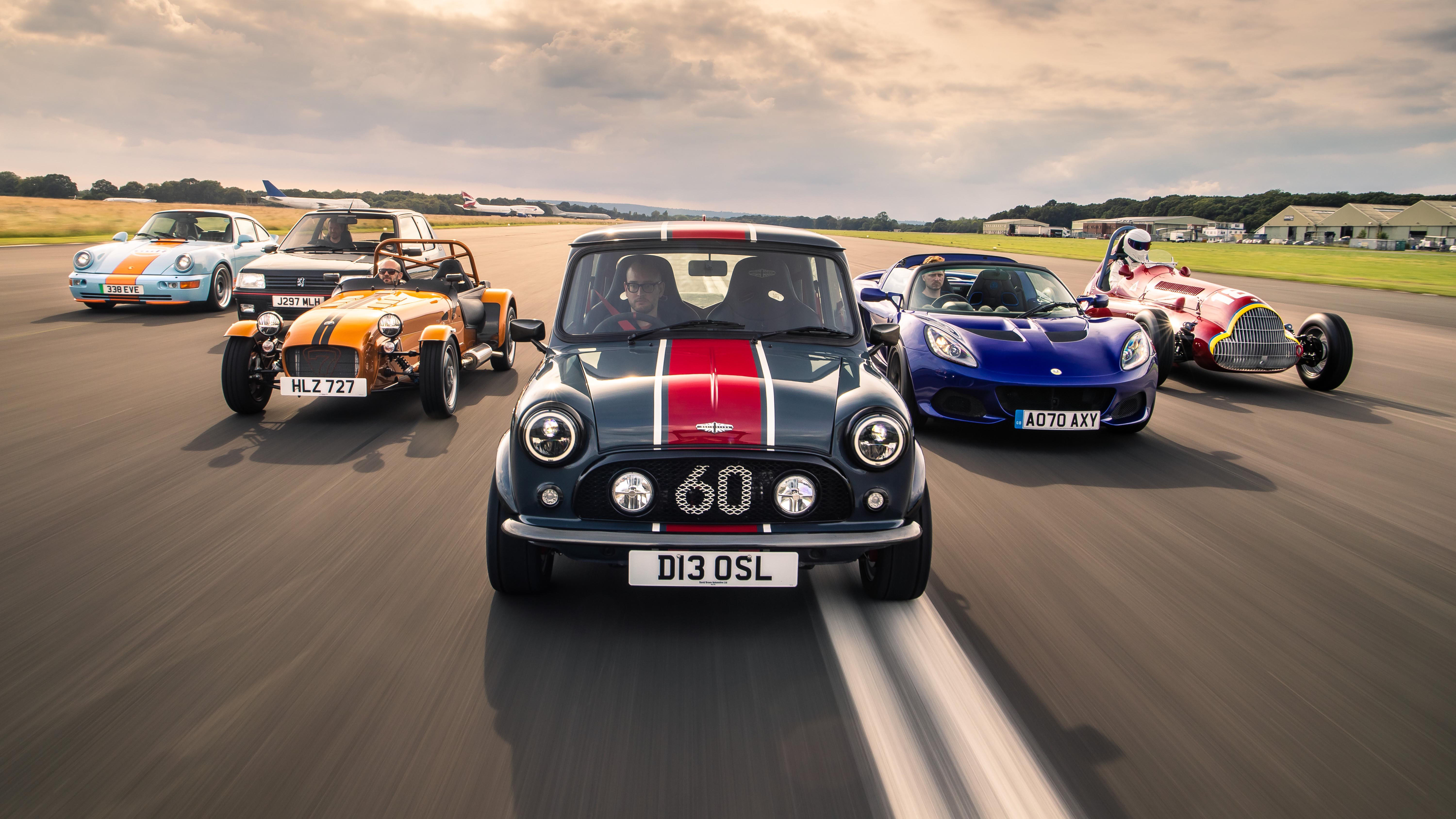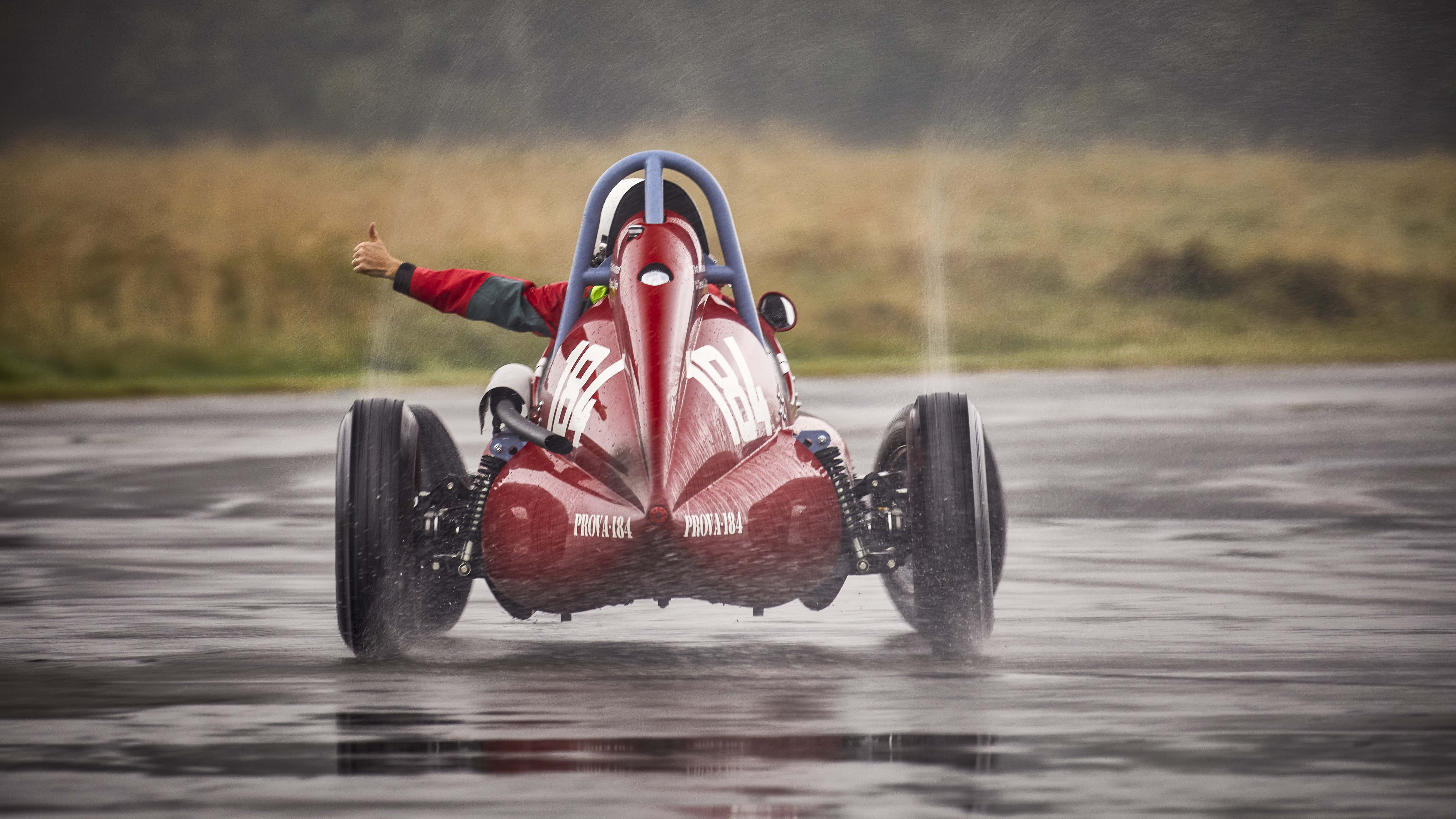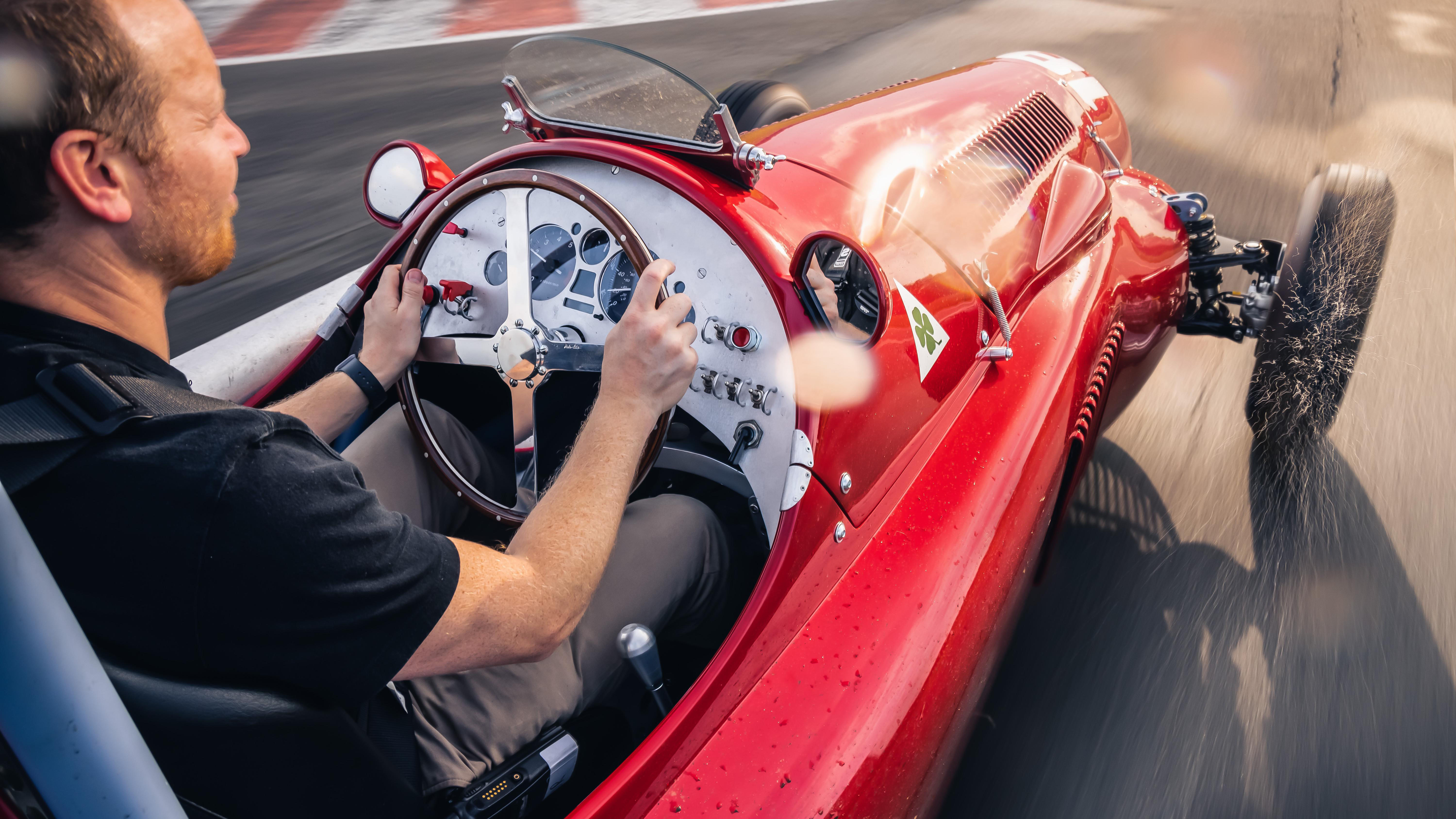
Memory lane: battle of the classics
Move over modern, hi-tech... stuff. It’s time for several blasts from the past
I'm calling it the crotch tickler. Maybe the nadger masher... haven't decided yet. Either way there’s a large piece of metal waggling around between my legs and making me feel ever so slightly on edge. Its linkage to the rounded knob in my right hand (steady) changes gear apparently, although there’s so much wind rush, spray and chunter from the engine I’ve got no idea what gear I’m in nor how fast I’m going. And I couldn’t care less because I’m sideways everywhere, beaming and basically a swashbuckling GP driver from the Thirties. Welcome to Memory Lane where even genital torture devices are thoroughly approved and imperfections aren’t just overlooked, they’re actively encouraged.
There’s a reason why retro is running through the car industry faster than chlamydia through Fresher’s Week – because with age comes character. Whether it’s laid on thick in the styling, or faithfully represented in the engineering, character is that intangible something you can sink your teeth into, but can’t be quantified on a spec sheet, the warm glow that follows you around long after you’ve parked up, the thing that sparks conversations and divides opinions. All the good stuff. So, as we gravitate towards our autonomous EV future, the demand for one last hit on the crack pipe is strong.
Which is why our band of ageing rockers is the best-attended event. Even getting it down to six took some whittling, such is the sheer weight of retro-infused metal that’s flooding the market. Restomods, better-than-new rebuilds, decades-old designs still sold as new and full-on, poking-the-purists EV conversions. We’ve got the lot. We’ve also got a MkII Mazda MX-5 that thinks it’s a historic F1 racer and can be built in your bedroom.
We’ll start with the Tipo 184, because it’s the one you can’t stop staring at, eyes flitting between the torpedo-like bonnet, and that wasp stinger rear end. It’s the work of Ant Anstead and the team at Dowsett Cars who wanted to offer an affordable and approachable project build for the average punter. For around £20k (plus a donor MkII MX-5 stripped of its engine, transmission and suspension) you can buy the kit and build one of these yourself in just a few days, depending on mechanical competence. That’s a lot of historic race car, for not a crippling amount of money.
But there are quirks. You summit the driver’s seat by stepping on the rear suspension, hurdling the hot exhaust and dropping onto a seat that feels both peculiarly high and upright. The enormous wooden wheel slots between your knees, your head pokes out some distance above the mostly decorative fly screen while the scrote-slicer looms large. But from there the familiarity grows: push button start, three pedals, a five-speed manual and that MX-5 trait of feeling healthy on full throttle, but never properly fast.
Photography: Jonny Fleetwood
What you do get is a period-appropriate growl from the exhaust that boomerangs past and behind you and an experience that’s about as detached from driving a modern car as is possible. At first awkward – to steer, to find third gear, to trust you’re unlikely to barrel roll through Hammerhead – then a sheer delight and you realise it just wants to play. Suddenly Stirling Moss’ observation that the wheel is merely to point a car in the direction of a corner, the steering is done by the throttle, rings true. It’s a silly car, it makes no real sense in the context of the competition here, and I find myself wanting to sign up for next year’s one-make series immediately. But I must move on, because it’s time for an argument.
The Everrati Signature looks like another smartly done Porsche 964 restomod, but it’s actually a pure electric conversion. Gasp, etc. Shocking, perhaps, but the engineering integrity is present and correct – Everrati actually weighs each donor car individually to ensure the battery dispersion perfectly mimics the original arse-heavy weight distribution.
It’s rear-wheel drive, has 500bhp, does 0–62mph in four seconds which means it goes like Stig off a shovel, weighs 1,350kg and has a 150-mile range. It’s nicely built too – not a patch on a Singer, but the chubby steering wheel, miles of Alcantara, official Porsche classic DAB radio and surprisingly squidgy seats all look great, plus the two pedals are authentically offset. Most importantly though, it just works – switch it on, select D, go about your day. Clings on gamely in the faster corners too, and it’s perfectly happy to drift and donut at will.
But there are problems. The fake exhausts that emit fake noise are just asking for trouble – it’s an electric car, celebrate the fact, delete the pipes – and the Gulf livery is a bit naff... but each to their own. Perhaps the thorniest issue is the price: £250k. We’re being conditioned to just take these vast sums in our stride, but let’s pause here – you could have a new 911 GT3 and a Taycan 4S Cross Turismo for that, with a Toyota GR Yaris’ worth of change. It’s a fascinating object but the character’s being polished out, which is a deal-breaker for me.
The Lotus Elise however, here in its Final Edition trim, is as sparkly as the day it was born. Three generations, 25 years, a switch from Rover power to Toyota engines and a fair old weight gain along the way, from 725kg back in the mid-Nineties when it had trick brakes, no airbag and no air-conditioning, to 930kg here. What we’ve got is an aluminium tub, a 1.8-litre supercharged 4cyl engine in the middle, good for 240bhp. Rear drive, manual box, 0–62 in 4.5 seconds and 147mph flatout.
There’s a robust argument for all just packing up, and giving the Elise the win right here and now
Still sounds like enough for a sports car, doesn’t it? And it absolutely is. The whole thing feels solid – a cohesive unit with steering talking to brakes, throttle chatting to the gearbox. Even in the streaming rain it’s a bubble of confidence and you can drive it how you like – loose and stupid or tight and precise. It’s simply an extension of your thought process, a neuron pathway and I know it probably wouldn’t be easy to live with, but I also know the rewards would be worth it – an unreliable but totally charming other half. Emira, meet gauntlet. I mean, there’s a robust argument for all just packing up, and giving the Elise the win right here and now, but there’s another old-timer in fresh threads that begs to differ.
Top Gear
Newsletter
Thank you for subscribing to our newsletter. Look out for your regular round-up of news, reviews and offers in your inbox.
Get all the latest news, reviews and exclusives, direct to your inbox.
The 170R, at 440kg, is the lightest Caterham ever. One well-specced LR Discovery equals six of these, it’s a car where skipping pudding would realistically improve performance on the drive home. And the engine here needs all the help it can get – the same 84bhp three-cylinder from the 160, but now married to all the lightweight carbon bits from the 620R – hence a power-to-weight ratio bump to 170. All Caterhams are pure but this is mountain-fresh, triple-distilled Evian with an oxygen chaser. On the surface it plays the part: an aero lip in place of the screen, the stubby short-throw gearlever, the crush to get your lockdown paunch into the seat and your feet into the pedal box. The limits of adhesion, thanks to the scrawny tyres, are hilariously low and the engine thrums away with enthusiasm, but there’s an imbalance here between purpose and power. It wants to thrill you, but is censored from fulfilling its potential. File this one under brilliant idea, but more grunt required.
Fortunately, if you’re craving something small, raucous and chuckable, something that doesn’t need big power to make you grin like an idiot, there are other options. The Mini Remastered Oselli Edition is the work of Silverstone-based David Brown Automotive, which has been knocking out high end restomod Minis for a few years now. This is the high-performance one. An enlarged, 1,450cc A-series engine with twin SU carburettors, significant internal mods and 125bhp at 6,200rpm. There’s also a limited-slip differential, AP Racing brakes, 13-inch wheels with wider tyres, adjustable Bilstein suspension, a five-speed manual gearbox and a rortier, freer-flowing sports exhaust system.
And the results are... mixed. In the wet it shows up to the party, handbrake-turning for the hell of it, sliding in then clawing its way out of corners and making one hell of a racket absolutely everywhere. But in the dry it feels soft compared to the promise of its spec sheet; the delay between steering input and the front end reacting is too protracted. It teeters on a knife edge between brilliant fun and a missed opportunity, and after two days of driving I still can’t make my mind up. Then I’m told the price and it’s a hard no from me. The four-seat version costs from £118,000, the two-seater starts at £130,000... and nope, it’s not 1 April.
I get it. Value for money is a tricky thing to nail down, it differs wildly depending on your bank balance and upbringing, and £45k for what looks like a standard Sorrento Green Peugeot 205 GTI 1.6 that’s had a once-over in Turtle Wax doesn’t make much fiscal sense either, but hear me out. Whereas the Mini’s development budget seems to have been mostly spent on Pioneer headsets, stitched leather and pinstripes, Tolman Engineering has focused its love on the bits of the 205 that matter most. A reconditioned engine with lighter flywheel, Motec ECU and 132bhp, a new stainless steel exhaust, Bilstein dampers, Eibach springs, LED lights all round, brakes from the 306 GTi6... the list goes on.
What you end up with is a better-than-new incarnation of a stone-cold hot hatch classic, improved and preserved for future generations to experience what zip and tactility really are. You sit too high, wheel in your lap, gazing out of the generous glazing past skinny pillars just lobbing it around and enjoying every second. The engine buzzing away in front, the weighty steering wheel wriggling about in your hands, the sunroof shade sliding forward with comic timing and period correct shoddiness every time you stand on the brakes. It’s wonderful, a full-on time machine that takes you back to a golden era. If there was one I could take home and keep forever, the antidote to copy-paste EVs, the Peugeot is the one.
Trending this week
- Car Review
BMW 1 Series











